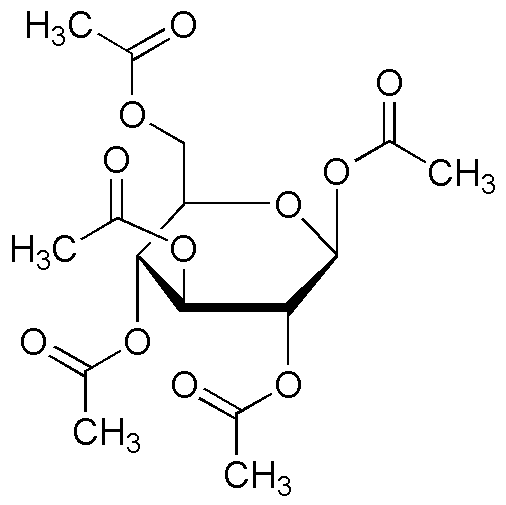b-D-Glucose pentaacetate is widely utilized in research focused on:
- Biochemical Research: This compound serves as a valuable tool for studying carbohydrate metabolism and enzyme activity, helping researchers understand metabolic pathways in living organisms.
- Drug Development: It is used in the synthesis of various pharmaceutical compounds, particularly in creating prodrugs that enhance bioavailability and therapeutic efficacy.
- Food Industry: As a food additive, it can be employed to modify the sweetness and stability of products, making it beneficial for food scientists working on flavor enhancement.
- Analytical Chemistry: The compound is utilized in chromatography and mass spectrometry for the analysis of sugars and other carbohydrates, providing precise identification and quantification.
- Cosmetic Formulations: It is incorporated into cosmetic products for its emollient properties, improving texture and moisture retention in skincare formulations.
General Information
Properties
Safety and Regulations
Applications
b-D-Glucose pentaacetate is widely utilized in research focused on:
- Biochemical Research: This compound serves as a valuable tool for studying carbohydrate metabolism and enzyme activity, helping researchers understand metabolic pathways in living organisms.
- Drug Development: It is used in the synthesis of various pharmaceutical compounds, particularly in creating prodrugs that enhance bioavailability and therapeutic efficacy.
- Food Industry: As a food additive, it can be employed to modify the sweetness and stability of products, making it beneficial for food scientists working on flavor enhancement.
- Analytical Chemistry: The compound is utilized in chromatography and mass spectrometry for the analysis of sugars and other carbohydrates, providing precise identification and quantification.
- Cosmetic Formulations: It is incorporated into cosmetic products for its emollient properties, improving texture and moisture retention in skincare formulations.
Documents
Safety Data Sheets (SDS)
The SDS provides comprehensive safety information on handling, storage, and disposal of the product.
Product Specification (PS)
The PS provides a comprehensive breakdown of the product’s properties, including chemical composition, physical state, purity, and storage requirements. It also details acceptable quality ranges and the product's intended applications.
Certificates of Analysis (COA)
Search for Certificates of Analysis (COA) by entering the products Lot Number. Lot and Batch Numbers can be found on a product’s label following the words ‘Lot’ or ‘Batch’.
Numéro de catalogue
Numéro de lot/série
Certificates Of Origin (COO)
This COO confirms the country where the product was manufactured, and also details the materials and components used in it and whether it is derived from natural, synthetic, or other specific sources. This certificate may be required for customs, trade, and regulatory compliance.
Numéro de catalogue
Numéro de lot/série
Safety Data Sheets (SDS)
The SDS provides comprehensive safety information on handling, storage, and disposal of the product.
DownloadProduct Specification (PS)
The PS provides a comprehensive breakdown of the product’s properties, including chemical composition, physical state, purity, and storage requirements. It also details acceptable quality ranges and the product's intended applications.
DownloadCertificates of Analysis (COA)
Search for Certificates of Analysis (COA) by entering the products Lot Number. Lot and Batch Numbers can be found on a product’s label following the words ‘Lot’ or ‘Batch’.
Numéro de catalogue
Numéro de lot/série
Certificates Of Origin (COO)
This COO confirms the country where the product was manufactured, and also details the materials and components used in it and whether it is derived from natural, synthetic, or other specific sources. This certificate may be required for customs, trade, and regulatory compliance.


